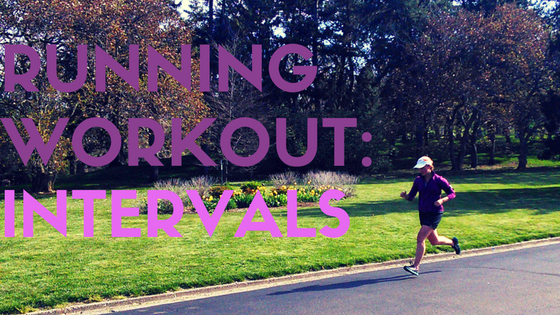Running Workout: Simple Intervals

If you’re new to interval work, it’s a great workout variation to incorporate into your training for any distance race, and especially helpful for triathletes. Plus, it breaks up the monotony of running the same route day after day (I hope you’re not doing that… if you are, here are some ways to mix it up) and packs an intense workout into a relatively short amount of time (and distance).
Intervals are short periods of very hard effort, followed by a recovery phase, bookended by an easy warm-up and cool-down.
Interval training is one way to get your body used to running at harder efforts– difficult to do if you’re still working on bumping up your mileage. You don’t want to limit yourself to only the distance you can currently run at race pace, especially if that distance is 2 miles and your race is 6 miles.
Even if you’re already comfortably at your race distance, your speed won’t improve if you either a) take every run easy or b) do every run at an all-out effort. If you were to try option A, you’d simply stagnate at your current fitness level. Option B leads to a pretty quick burn out– much faster than your pace would increase (this is the problem behind the “race yourself fit” training plan… or lack of plan, as it were, that I stupidly followed in college).
To get nitty-gritty about it, intervals train your fast-twitch muscle fibers (the sprinting part of your muscles), and let your legs get accustomed to a faster cadence (rate of turnover). Both of these things are necessary to run fast at any distance. When you run hard, your muscles are flooded with free radicals. After a period of time, your muscles get tired of dealing with these bad boys and your effort has to drop. While you recover, they adapt to the increased load of free radicals, and next time are able to deal with them more efficiently. If you were to start out hard and gradually taper your effort (as naturally happens), the flood of free radicals would also gradually taper. However, in between each interval effort, your muscles start to recover and adapt to the flood of free radicals before they’re bombarded again. Ultimately, your muscles adapt faster to intervals than they would have to a long steady effort.
In other words, interval workouts make you better at working hard while already tired, something triathletes have to do, particularly in the run segment. (Oh, what’s that? You can’t run because you just went for a bike ride? Sorry, not gonna fly.) Rather than running one mile hard, burning out and then taking it easy for another four, intervals wear you out little by little so that you run your last interval at the same effort (if not necessarily the same speed) as the first.
I did this simple set of intervals today, on relatively flat terrain, and covered 5.5 miles. Your distance will vary depending on your usual run pace. You could increase the intensity by finding a hilly area or increasing the number of repetitions. Decrease the intensity (and distance covered) by either shortening the “work” phase, lengthening the “recovery” phase, or decreasing the total number of reps.
My watch has an interval function that allows me to mix time and distance– yours might, too! Otherwise, you can convert the warm-up and cool-down to time by multiplying your usual mile pace by 1.5 and use a timer on your phone. There are HIIT (high intensity interval training) timers available for just about all phones, or you can “hack” your phone’s built-in timer function.
Beginner’s Interval Workout
Distance: 4- 7 miles
Warm-up: 1.5 miles extra easy conversational pace, aka Zone 1, RPE 4
Repeat the following two segments (work + rest) eight times:
Work: 1 minute hard running, aka Zone 4-5, RPE 8-9. This is the fastest pace that you can sustain for one minute. If you can talk, you can run harder.
Rest: 2 minutes easy running, aka Zone 2, RPE 5. Back to your conversation with your running buddy, but not quite as easy as the warm-up.
Cool-down: 1.5 miles extra easy conversational pace, aka Zone 1, RPE 4. You can slow to a walk toward the end of your cool down. The idea is to taper down your speed gradually so you avoid the icky feelings you get with sudden pace changes.